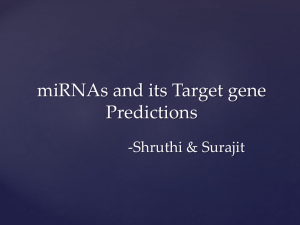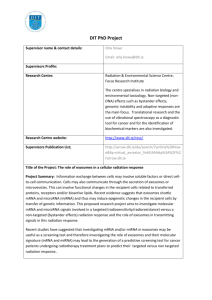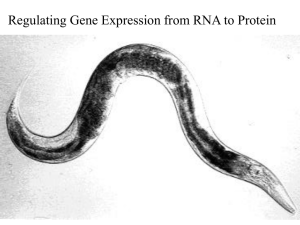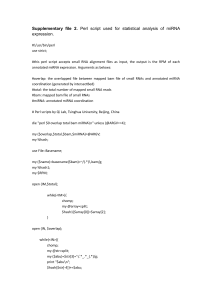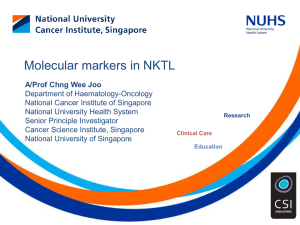Umapathy-proposal - University of South Australia
advertisement
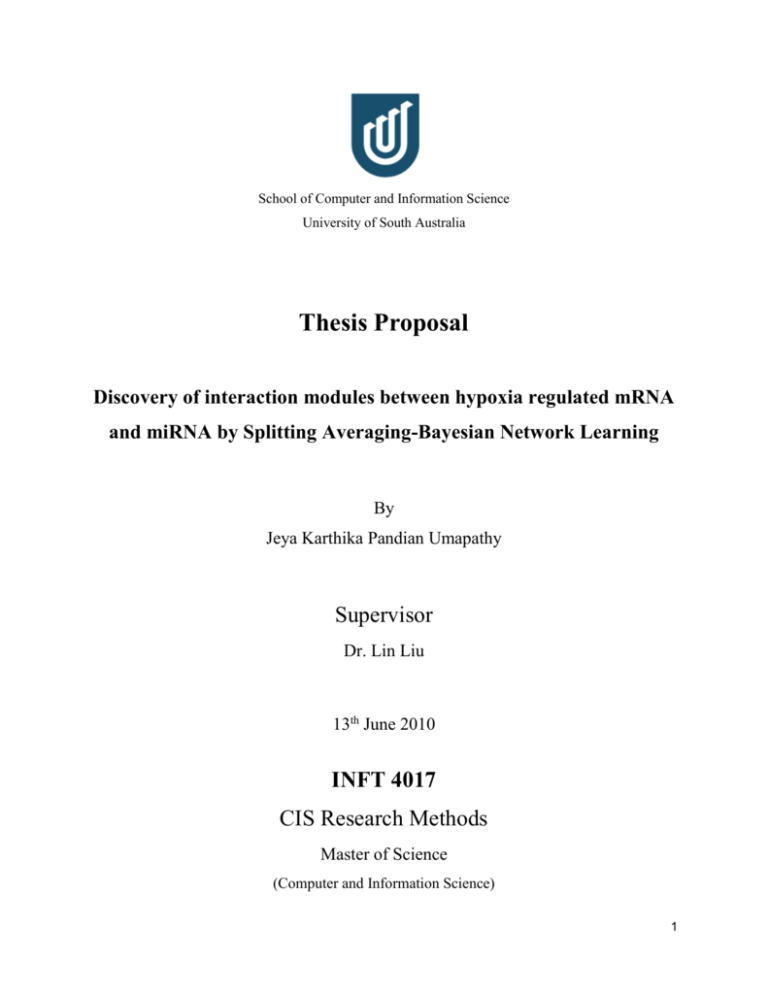
School of Computer and Information Science University of South Australia Thesis Proposal Discovery of interaction modules between hypoxia regulated mRNA and miRNA by Splitting Averaging-Bayesian Network Learning By Jeya Karthika Pandian Umapathy Supervisor Dr. Lin Liu 13th June 2010 INFT 4017 CIS Research Methods Master of Science (Computer and Information Science) 1 Abstract Biologists suspect that the miRNA mediates the hypoxia induced suppression of mRNA expression post-transcriptionally, in breast cancer affected cells. Manual discovery of interaction modules between the miRNA and mRNA proves to be impossible owing to the large data set. Hence, we use a computational method using Splitting Averaging – Bayesian Networks, proposed by Liu et al., for learning any connections between miRNA and mRNA datasets derived from breast cancer affected cells. The research helps the biologists in confirming their assumptions. We also propose to validate this computational method proposed by Liu et al., in terms of usefulness and effectiveness, in discovering the miRNA-mRNA interactions. Keywords miRNA, mRNA, Hypoxia, HIF, gene expression, post-transcriptional, down-regulation, Upregulation, mixed-regulation, Splitting Averaging Bayesian network strategy. 2 Contents 1. Introduction 1.1. Background ...4 …4 1.1.1. Ribonucleic Acids (RNAs) …4 1.1.2. Messenger RNA (mRNA) …5 1.1.3. MicroRNA (miRNA) …5 1.1.4. miRNA functions …6 1.2. Research questions …6 1.3. Scope and limitations …7 2. Literature Review …8 2.1. Why to learn miRNA-mRNA interactions? …8 2.2. Effect of Hypoxia on mRNA …8 2.3. Computational Methods – Why? …9 2.4. Related Works …9 3. Research Methodology …10 3.1. SA – BN Strategy …11 3.2. Process flow …12 3.3. Tools Used …12 3.4. Data Sources …13 4. Expected Outcomes …13 5. Conclusion …14 Appendix A – Extended Abstract …15 Appendix B – Process flow of the SA-BN strategy …16 Appendix C – miRNA interactions inside the cell …17 Appendix D – Time Line for the research …18 Appendix E – Tentative thesis chapters outline …21 References …23 3 1. Introduction The advancement in the computing field marked the beginning of Bioinformatics during 1960's. With the advent of internet, the field was blotted with remarkable findings which would have otherwise been difficult. The alliance between genomics and bioinformatics aided the quest to reveal the mechanisms going on inside the minuscule cell of the human body at molecular level. 1.1. Background In an attempt to understand the events at molecular level, it was discovered that ribosomes were the hub of protein synthesis and that the messages were transmitted from DNA to the ribosomes through RNA (Paustian & Roberts 2006). This discovery by Sydney Brenner, Francois Jacob and Matthew Meselson in 1961 accelerated the interests in the field and raised numerous questions in the minds of biologists (Paustian & Roberts 2006). 1.1.1. Ribonucleic Acids (RNAs) RNA became the source of attraction to biologists and was investigated frequently. The RNA's were found to constitute about 60% of the ribosome’s weight and it plays an indispensable role in catalyzing the protein synthesis (Moore & Steitz 2002). RNA or the Ribonucleic Acid is a nucleotide polymer, which is 21 to 25 nucleotides in length (Lagos-Quintana et al. 2001). Each nucleotide has a nitrogenous base, a ribose sugar, and a phosphate (Barciszewski & Clark 1999). The nitrogenous bases found in RNA are Cytosine, Guanine, Adenine and, Uracil, which are abbreviated respectively as C, G, A and U. 4 As a part of ribosome, RNA has a biological significance owing to its role in DNARibosome communication and protein synthesis (Clancy 2008). RNA has been classified into numerous types based on its function as snRNA or Small Nuclear RNA, siRNA or Small Interfering RNA, snoRNA or Small Nucleolar RNA, miRNA or microRNA, tRNA or transfer RNA, mRNA or messenger RNA and rRNA or the ribosomal RNA (Clancy 2008). 1.1.2. Messenger RNA (mRNA) The messenger RNA is a single stranded RNA, which plays the role of the communicator. The mRNA is formed inside the nucleus of the cell by the transcription of DNA molecule. After the mRNA matures, it transports the “protein-blue prints” from the DNA to the ribosomes in the cytoplasm, for the purpose of protein synthesis (Clancy 2008 & Johnston & Bose 1972). The interactions of the mRNa inside the cell can be understood from the figure in Appendix C. 1.1.3. MicroRNA (miRNA) The first miRNA, lin-4 was initially found to exist in C. elegans (Bentwichet al. 2005, Berezikov et al. 2006, Lee et al. 1993 & Wightman et al. 1993). From then on it was tracked through numerous species including humans and its functions were elucidated. So far many hundreds of miRNAs have been found and this figure is speculated to increase tremendously with further investigation of cells at molecular level (He & Hannon 2004). It has been found that they are mostly single stranded and non-coding nucleotide polymers (Lagos-Quintana et al. 2001). 5 1.1.4. miRNA functions The miRNAs play a prominent role in cellular activities ranging from cell differentiation to development (Ambros 2004, Bushati & Cohen 2007 & Du & Zamore 2007). The identification of the regulatory targets of the miRNAs aids in determining the miRNA functions based on the functions of the target (Bartel 2004, Enright et al. 2003 & Lewis et al. 2003). In the words of Barciszewski & Clark (1999, pp. 10), miRNA performs a ‘feat of gymnastics’ in the cellular level. Changes in miRNA mediates changes in the neural system (De Pietri Tonelli et al. 2008), immune system (Schickel 2008), cardiac system (Divakaran et al. 2008), etc.. The most significant being its ability to control the translation of mRNA either by accelerating or degrading its expression post-transcriptionally (Shyu et al. 2008). It can upregulate, down-regulate and mix-regulate mRNA gene expression. 1.2. Research questions The messenger RNA which is affected by Hypoxia (Hypoxia is actually a condition of human body during which the oxygen supply to the tissues is well below the normal physiological requirement. This is prevalent in case of an occurrence of certain abnormal changes in the tissue or cell) has been observed to result in the repression or down-regulation of mRNA in the MCF7 breast cancer derived cells. The biologists suspect that this may have been mediated by the changes occurring in miRNA. We propose to test this hypothesis by applying a computational method proposed by Liu et al., (2009b) and finding whether miRNA has any interesting interactions with the hypoxia affected mRNA. 6 ? mRNA affected by Hypoxia Down-regulation of mRNA According to the work of Mole et al. (2009), it is found that Hypoxia Inducible Factor (HIF) plays an indirect role in the gene repression of hypoxia affected mRNA. Hence this raises a new suspicion that the gene repression by hypoxia could have been mediated by the miRNA. So, the construction of the network of miRNA-mRNA interactions will enable the inference of any interesting connections between them leading to the confirmation of the hypothesis. mRNA affected by Hypoxia 1.3. Mediated by changes in miRNA Down-regulation of mRNA Scope and limitations The thesis focuses only on the breast cancer affected cells. It focuses on finding the interactions between the miRNA and hypoxia regulated mRNA, which may prove that the gene repression of hypoxia regulated mRNA was mediated by the changes in miRNA. The research may or may not find new interactions between miRNA and mRNA. However it does not concentrate on finding any new connections between mRNA and miRNA. The thesis also focuses on validating the computational method proposed by Liu et al. (2009b) in terms of the usefulness and effectiveness in this particular application area. 7 2. Literature Review 2.1. Why to learn miRNA-mRNA interactions? The changes in miRNA gene regulation are known to cause abnormalities in human body leading to diseases like cancer (Wienholds & Plasterk 2005). Up-regulation, down-regulation and mixed-regulations were observed to be caused by miRNA but mostly, down-regulation dominated in tumors (Lu et al. 2005). The disruption of its rheostatic function (Baek et al. 2008) causes tumor development and also accelerates the carcinogenic tumor growth to malignant state. The study of miRNA regulation networks and targets, will henceforth aid us in understanding the cause for the abnormal physiological conditions and enlighten the otherwise unknown biological procedures of human body (Liu et al. 2009a). 2.2. Effect of Hypoxia on mRNA Hypoxia can be described as a condition in human body during which the whole human body or merely a part of it is affected by a decrease in the oxygen supply. This condition helps in the process of proper metabolism in the cellular level and also sometimes the regulation of the numerous genes in the human body (Mole et al. 2009). The blood flowing through the arteries delivers the oxygen to the cells by diffusion. During this diffusion, the partial pressure is usually 100mmHg. But, if this pressure falls below 40mmHg, it becomes lethal. When this insufficiency occurs, lactic acid is formed from the hydrogen for producing little energy by temporary anaerobic metabolism. The increase in lactic acid inside the cell may cause inadequate blood flow, hypoxemia, etc.., often leading to death (Roach et al. 2001). 8 Recent research on the MCF7 cells (breast cancer affected cells) reveals that hypoxia suppresses the mRNAs from expessing their genes. The research by Mole et al. (2009) reveals that the Hypoxia Inducible Factor (HIF) indirectly suppresses the gene regulation. Hence, it raises the possibility that miRNAs could have been mediated the down-regulation of mRNA suppressed by hypoxia. 2.3. Computational methods - Why? The biologists obtained the mRNA (Elvidge et al. 2009) and miRNA (Camps et al. 2009) data from the breast cancer derived cells. On the precinct of verifying the hypothesis, the large number of possible combinations proves manual analysis and verification as impossible. Hence, it is difficult for the biologists to test every possible connection between miRNA and mRNA pairs to verify the hypothesis. So, we utilize computational approaches and methods to identify any connections between the miRNA and mRNA data. 2.4. Related Works The past few years has seen many computational methods for the purpose of validating the possible hypotheses regarding the miRNA targeting information. In 2005, Yoon et al. came up with a new computational method based on prediction, depending on the idea that the binding structure between the miRNA and the mRNA will be normal and it’s the same even if many binding sites exists on the mRNA. He used weighted bipartite graphs to form the binding structures between the micro and messenger RNA. But, this resulted in a higher rate of false discovery since it relied only on the sequence data. 9 Bayesian parameter learning was used by Huang et al. (2006) to learn the interactions between miRNA and mRNA using both sequence data and expression data. The bi-clustering approach (Joung et al. 2007) utilizing the expression profile data and sequence information ventured to find the miRNA regulatory modules (MRMs). A rule-based approach was proposed by Tran et al., to study miRNA-mRNA interactions assuming that expression profiles of miRNA and mRNA will be quite similar in a given module. The above mentioned methods have minimal false discovery rate but, fail to use a sample category which is a critical factor since many of the biological experiment data measure up to different phenotypic or conditional groups. The functional miRNA-mRNA regulatory modules (FMRMs) were learnt for the miRNA and target mRNA special conditions by Liu et al. (2009a). But, this work focused only on downregulation. The next paper by Liu et al., (2009b) used Splitting Averaging - Bayesian Network strategy to discover the miRNA-mRNA interactions utilizing the target sequencing information, expression profiles of miRNA and mRNA. This work covers all the down & up regulation and also provided a method to analyze miRNA-mRNA interactions in various physiological disorders. This strategy posed minimal false discovery rate by using the sample category information. Hence, we propose to use this strategy for learning the miRNA-mRNA interactions. Additionally, due to the fact that the author of the paper works in the same university, we are able to get a good amount of guidance and information. 3. Research Methodology Of the various Computational methods, Construction of the network structure has gained importance in building diagnostic models for diseases like cancer (Sebastiani et al. 2004). And, 10 Bayesian network learning has been found to best serve the purpose. Variations in the normal Bayesian network structure learning yields better results in our application area. 3.1. SA-BN Strategy The methodology employed to discover the regulatory interaction modules between hypoxia regulated mRNA and miRNA is the Splitting Averaging-Bayesian Network Learning strategy. “Bayesian network is actually a probabilistic graphical model which signifies a set of arbitrary variables and their conditional dependencies using directed acyclic graph” (Heckermann 1995). It can be used to construct the probabilistic relationship network for pathological conditions. A Bayesian network consists of n nodes (representing a random variable, attribute or a hypothesis) connected via edges (representing the existence and direction of relationship). It can be used to learn unobserved variables in the network, for learning about the parameters, or to learn about the structure. There are numerous algorithms for learning Bayesian networks. In Splitting Averaging – Bayesian network learning, we actually split the dataset based on the sample category information. This is followed by Bayesian network learning for the split data. Now, The Bayesian networks learnt from split data are merged together in to a single network using the averaging strategy. This reduces the false discovery rate. The process of learning Bayesian networks computationally proves to be impossible, owing to the large data set and the fact that exponentially increasing number of network structures is possible. We utilize the miRNA targeting information to limit such possibilities (Liu 11 et al. 2009b). Hence, we utilize the target sequencing information to minimize the false discovery rate (Liu et al., 2009b). 3.2. Process Flow In this method, we use the expression profiles of miRNA and mRNA along with the target sequencing information to learn a Bayesian network of miRNA-mRNA interactions. The normalized differentially expressed profile datasets of miRNA and mRNA are split based on sample category information. We discretize the expression profile data as a measure to standardize them, since it is obtained from different platforms. We now use the Bayesian network learning to obtain the interaction dependencies between the discretized data of miRNA and target mRNA. The two structures learnt from the split data are now merged using the averaging strategy of Bayesian Networks. This process is illustrated in the process flow diagram in the Appendix B. 3.3. Tools Used The free open source data mining tool “R package” written initially by Robert Gentleman and Ross Ihaka in 1997 and improved till date, is used for the purpose of pre-processing the datasets. The R package tool is continuously being used for the statistical purposes and graphs. It has nearly become the de-facto for data-mining. We use the current version, R 2.11. released on 31st May 2010 for our research. Further to R, we also use the Bio-conductor package, “BioC” for the purpose of analysis of genomic data. This is an open source add-on for R package especially to analyse DNA and 12 RNA microarray experiment datasets. We use the current developer version, BioC 2.6 for our research. 3.4. Data Sources We use heterogeneous data in our computational approach. This includes miRNA target information, expression profiles of miRNA and expression profiles of mRNA. Numerous databases are available for the miRNA targeting information, for example, miR-200 can be used for our research (Griffths-Jones, 2008). We use the differentially expressed profile data of miRNA obtained from Array Express (http://www.ebi.ac.uk/microarray-as/ae/) using the accession number E-MEXP-1111 (Camps et al. 2009). The differentially expressed profile data of mRNA is obtained from GEO (http://www.ncbi.nlm.nih.gov/geo/) using the GEO accession number GSE3188 (Elvidge et al. 2009). These are samples from the breast cancer affected MCF7 cells. 4. Expected Outcomes We expect to obtain the possible connections between the hypoxia regulated mRNA and changes in miRNA after the final merging of the Bayesian network. We expect to find some of the targets for miRNAs from the mRNA repressed by Hypoxia. The results will confirm the already proved literature and may enlighten us with new possibilities. The use of heterogeneous data and sample categories is expected to minimize the false discovery rate. We also expect to validate the usefulness and effectiveness of this computational method proposed by Liu et al., (2009 b). 13 5. Conclusion In this research, we utilize an existing computational approach of Splitting Averaging – Bayesian Network learning to infer the complex miRNA-mRNA interactions in breast cancer affected cells. The research helps in validating the hypothesis of the effect of hypoxia on the breast cancer derived cells as well as in determining the usefulness of the SA-BN strategy in inferring the miRNA-mRNA interactions. 14 Appendix A Extended Abstract The Ribonucleic Acid (RNA), which is a nucleotide polymer, plays a prominent role in protein synthesis and the regulation of gene expression. Of the various types of RNAs, the microRNA (miRNA) controls messenger RNA (mRNA) translation by accelerating or degrading its expression. This has been found to be the cause for various abnormalities in human bodies. Current research reveals that miRNAs are responsible for gene regulations by posttranscriptional control of their mRNAs and, it may result in the development of tumor or even inducing the carcinogenic tumor growth to malignant state. Hence it proves vital to know the miRNA-mRNA interactions to aid the prevention and treatment of various physiological conditions. Recent research on the breast cancer affected cells reveals that the expression of mRNAs is suppressed by hypoxia. Biologists have discovered that HIF (Hypoxia Inducible Factor) indirectly regulates the gene expression. This has led them to assume that miRNAs could be the indirect reason for suppression of mRNA expression by hypoxia. However, given the large number of mRNAs and miRNAs, it is impossible for biologists to test each and every miRNAmRNA pair, to verify their assumption. In this research, we apply a computational method proposed by Liu et al., on the miRNA and mRNA expression data sets obtained from breast cancer derived cells, to discover possible connections between the miRNAs and mRNAs and, help biologists to verify their assumption on the role of miRNAs mediating the suppression of mRNA expressions by hypoxia. At the same time, we want to validate the usefulness and effectiveness of the method proposed by Liu et al., in discovering meaningful miRNA-mRNA interactions in this application area. 15 Appendix B Process flow of the SA-BN Strategy (Source: Liu, B, Li, J, Tsykin, A, Liu, L, Gaur, A & Goodall, G 2009b, 'Exploring complex miRNA-mRNA interactions with Bayesian networks by splitting-averaging strategy', BMC Bioinformatics, vol. 10, no. 1, pp. 408) 16 Appendix C miRNA interactions inside the cell (Source: National Institutes of Health, “Talking Glossary of Genetic Terms”, National Human Genome Research Institute, Viewed on June 12 2010, <http://www.genome.gov/glossary/?id=123>) 17 Appendix D Time Line for Study Period 2, 2010 SP 2, 2010 Tasks Week 1 Supervisor Search Finalization. Meeting the Supervisor. Week 2 Decide on the Research Area. Go through the base papers. Week 3 Start Background Study on Bio-informatics. Learn about Bayesian Networks. Week 4 Decide on meeting schedule and working space. Complete the Induction program. Continue background study. Week 5 Deeper discussion about the research area. Determine the exact objectives and requirements of the research. Continue Background study. Week 6 Start working on the thesis abstract. Submit a document to test the understanding about the research. Discussion of the document and base paper. Teaching Break Start working on literature review. Learn how to use R package. Teaching Break Submit an annotated list of bibliography to be used in the literature review. 18 Discussion of the annotated bibliography. Completion and review of the thesis abstract. Week 7 Submission of thesis abstract. Start working on thesis proposal. Week 8 Work on the literature review. Meeting with Bing Liu to understand the concepts and methodology to be used. Week 9 Complete the literature review. Start on the methodology and remaining parts of proposal. Week 10 First draft submission to supervisor. Prepare Extended Abstract and send to supervisor. Week 11 Feedback discussion for the first draft and extended abstract. Submit Extended Abstract Week 12 Second draft submission to supervisor and feedback. Third draft submission to Supervisor and feedback. Presentation slides preparation and feedback. Week 13 Presentation and Thesis Proposal. 19 Time Line for Study Period 5, 2010 SP 5, 2010 Tasks Week 1 Start Data Preparation. Week 2 Complete data preparation. Week 3 Input the data to the Software for learning the miRNA and mRNA connections and obtain results. Week 4 Analyze the results. Work on the thesis Literature review. Week 5 Work on the Thesis Methodology. Week 6 Finalize the results of analysis. Complete the Literature review and Methodology. Week 7 Validate the methodology used. Determine its usefulness and efficiency. Teaching Break Work on the results for the thesis. Teaching Break Work on recommendations and conclusion of the thesis. Week 8 First draft submission to supervisor. Week 9 First draft feedback and discussion. Prepare abstract for the thesis. Week 10 Second draft submission to supervisor. Week 11 Second draft feedback and discussion. Prepare presentation slides. Week 12 Final draft of thesis and discussion. Presentation slides feedback and discussion Week 13 Presentation and Final Thesis submission. 20 Appendix E Tentative Thesis Chapters Outline 6. Introduction 6.1. Background 6.2. Motivation 6.3. Research Purpose 6.4. Research Objectives 6.5. Scope and Limitations 6.6. Thesis Organization 7. Literature Review 7.1. Background 7.2. miRNA and mRNA Interaction 7.3. Effect of Hypoxia 7.4. Methods to discover miRNA-mRNA interaction modules 7.5. Computational discovery of miRNA-mRNA interaction modules 7.6. Various Computational methods 7.7. Use of Bayesian Networks in Bio-informatics 7.8. Splitting Averaging – Bayesian Network Learning 7.9. Related Works 8. Research Methodology 8.1. Data sources 8.2. Data mining tools 8.3. Data Pre-processing 8.3.1. Splitting the data 8.3.2. Results and observations 8.4. Learning the interaction Bayesian network 21 8.4.1. Learning network from the Split dataset 8.4.2. Combining the network by Averaging strategy 9. Results and Proceedings 9.1. Identifying the connections between miRNA and mRNA 9.2. Inference from the SA-BN learning 9.3. Observations 9.4. Validation of SA-BN Strategy 9.4.1. Usefulness 9.4.2. Effectiveness 9.4.3. Results and observations 10. Discussion 11. Recommendations 12. Conclusion 13. References 22 References Ambros, V 2004, 'The functions of animal microRNAs', Nature, vol. 431, no. 7006, pp. 350-355. Baek, D, Villen, J, Shin, C, Camargo, FD, Gygi, SP & Bartel, DP 2008, 'The impact of microRNAs on protein output', Nature, vol. 455, no. 7209, pp. 64-74. Barbato, C, Arisi, I, Frizzo, ME, Brandi, R, Da Sacco, L & Masotti A 2009, 'Computational Challenges in miRNA Target Predictions: To Be or Not to Be a True Target?', Journal of Biomedicine & Biotechnology. Barciszewski, J & Clark, BFC 1999, 'Why RNA?' in RNA Biochemistry and Biotechnology, Kluwer Academic Publishers, Netherlands, pp. 1-10. Bartel, DP 2004, 'MicroRNAs: genomics, biogenesis, mechanism, and function', Cell, vol. 116, pp. 281 - 197. Bentwich, I, Avniel, A, Karov, Y, Aharonov, R, Gilad, S & Barad, O 2005, 'Identification of hundreds of conserved and nonconserved human micrornas', Nature Genetics, vol. 37, pp. 766– 770. Berezikov, E, Cuppen, E & Plasterk, RHA 2006, 'Approaches to microrna discovery', Nature, Genetics, vol. 38, pp. S2–7. Bushati, N & COHEN, S 2007, 'microRNA Functions', The Annual Review of Cell and Developmental Biology, vol. 23, no. 1, pp. 175-205. Camps, C, Buffa, FM, Colella, S, Moore, J, Sotiriou, C, Sheldon, H, Harris, AL, Gleadle, JM & Ragoussis, J 2008,'hsa-miR-210 is induced by Hypoxia and is an independent prognostic factor in breast cancer', American Association for Cancer Research Journal, vol. 14, no. 5, pp. 13401348. Clancy, S 2008, 'RNA Functions', Nature Education, vol. 1, no. 1. 23 De Pietri Tonelli, D, Pulvers, JN, Haffner, C, Murchison, EP, Hannon, GJ & Huttner, WB 2008, ‘miRNAs are essential for survival and differentiation of newborn neurons but not for expansion of neural progenitors during early neurogenesis in the mouse embryonic neocortex. Development’, vol. 135, pp. 3911–3921. Divakaran, V, Mann & DL 2008, ‘The emerging role of miRNAs in cardiac remodeling and heart failure’, Circulation Research, vol. 103, pp. 1072–1083. Du, T & Zamore, PD 2007, 'Beginning to understand microRNA function', Cell, vol. 17, no. 8, pp. 661-663. Elvidge, GP, Glenny‡, L, Appelhoff, RJ, Ratcliffe, PJ, Ragoussis, J & Gleadle, JM 2006, 'Concordant Regulation of Gene Expression by Hypoxia and 2-Oxoglutarate-dependent Dioxygenase Inhibition : the role of HIF-1, HIF-2, and other pathways', The Journal of Biological Chemistry, The American Society for Biochemistry and Molecular Biology, vol. 281, no. 22, pp. 15215-15226. Enright, AJ, John, B, Gaul, U, Tuschl, T, Sander, C, & Marks, DS 2003, 'MicroRNA targets in Drosophila', Genome Biology, vol. 5. Griffths-Jones, S, Saini, HK, van Dongen, S & Enright, AJ 2008, 'miRBase: tools for microRNA genomics', Nucleic Acids Research, vol. 36, no. 1, pp. D154-158. He, L & Hannon, GJ 2004, 'Micro RNAs: Small RNAs with a big role in gene regulation', Nature Reviews, Genetics, vol. 5, pp. 522–531. Heckermann, D 1995, 'A Tutorial on Learning with Bayesian Networks', Innovations in Bayesian Networks, vol. 156, pp. 33-82. 24 Huang, JC, Morris, QD & Frey, BJ 2006, 'Detecting MicroRNA Targets by Linking Sequence, MicroRNA and Gene Expression Data', Research in Computational Molecular Biology, vol. 3909, pp. 114-129. Johnston, RE & Bose, HR 1972, 'Correlation of Messenger RNA Function with Adenylate-Rich Segments in the Genomes of Single-Stranded RNA Viruses', Proceedings of the National Academy of Science, USA, vol. 69, no. 6, pp. 1514-1516. Joung, JG, Hwang, KB, Nam, JW, Kim, SJ & Zhang, BT 2007, 'Discovery of microRNA mRNA modules via population-based probabilistic learning', Bioinformatics, vol. 23, no. 9, pp. 11411147. Lagos-Quintana, M, Rauhut, R, Lendeckel, W & Tuschl, T 2001, 'Identification of novel genes coding for small expressed RNAs', Science, vol. 294, no. 5543, pp. 853–858. Lee, RC, Feinbaum, RL & Ambros, V 1993, 'The C. elegans heterochronic gene lin-4 encodes small RNAs with antisense complementarity to lin-14', Cell, vol. 75, no. 5, pp. 843–854. Lewis, BP, Shih, I, Jones-Rhoades, MW, Bartel, DP & Burge, CB 2003, 'Prediction of mammalian microRNA targets', Cell, vol. 115, pp.787–798. Liu, B, Li, J & Tsykin, A 2009a, 'Discovery of functional miRNA–mRNA regulatory modules with computational methods', Journal of Biomedical Informatics, vol. 42, no. 4, pp. 685-691. Liu, B, Li, J, Tsykin, A, Liu, L, Gaur, A & Goodall, G 2009b, 'Exploring complex miRNAmRNA interactions with Bayesian networks by splitting-averaging strategy', BMC Bioinformatics, vol. 10, no. 1, pp. 408. Lu, J, Getz, G, Miska, EA, Alvarez-Saavedra, E, Lamb, J, Peck, D, Sweet-Cordero, A, Ebert, BL, Mak, RH, Ferrando, AA, Downing, JR, Jacks, T, Horvitz, HR & Golub, TR 2005, ‘MicroRNA expression profiles classify human cancers’, Nature, vol. 435, pp. 834–838. 25 Mole, DR, Blancher, C, Copley, RR, Pollard, PJ, Gleadle, JM, Ragoussis, J & Ratcliffe, PJ 2009, 'Genome-wide Association of Hypoxia-inducible Factor(HIF)-1α and HIF-2α DNA Binding with Expression Profiling of Hypoxia-inducible Transcripts', The Journal of Biological Chemistry, The American Society for Biochemistry and Molecular Biology, vol. 284, no. 25, pp. 1676716775. Moore, P. B. & Steitz, T. A. 2002, 'The involvement of RNA in ribosome function', Nature, vol. 418, no. 6894, pp. 229-235. National Institutes of Health, “Talking Glossary of Genetic Terms”, National Human Genome Research Institute, Viewed on June 12 2010, <http://www.genome.gov/glossary/?id=123> Paustian, T & Roberts, G 2006, Through the microscope: a look at all things small, Lulu.com. Roach, RC, Wagner, PD & Hackett, PH 2001, Hypoxia: from genes to the bedside, Kluwer Academic/Plenum Publishers, New York. Sebastiani, P, Abad, MM & Ramoni, MF 2004, ' Bayesian networks for genomic analysis'. Schickel, R, Boyerinas, B, Park, SM & Peter, ME 2008, ‘MiRNAs: key players in the immune system, differentiation, tumorigenesis and cell death’, Oncogene, vol. 27, pp. 5959–5974. Shyu, A-B, Wilkinson, MF & van Hoof, A 2008, 'Messenger RNA regulation: to translate or to degrade', EMBO Journal, vol. 27, no. 3, pp. 471-481. Tran, DH, Satou, K & Ho, TB 2008, 'Finding microRNA regulatory modules in human genome using rule induction', BMC Bioinformatics, vol. 9, no. 12, pp. S5. Wang, G, Jiang, B, Rue, E & Semenza, G 1995, 'Hypoxia-Inducible Factor 1 is a Basic-HelixLoop-Helix-PAS Heterodimer Regulated by Cellular O2 Tension', PNAS, vol. 92, no. 12, June 6, 1995, pp. 5510. 26 Wienholds, E & Plasterk, RHA 2005, 'MicroRNA function in animal development', Federation of European Biochemical Societies Letter, vol. 579, no. 26, pp. 5911-5922. Wightman, B, Ha, I & Ruvkun, G 1993, 'Posttranscriptional regulation of the heterochronic gene lin-14 mediates temporal pattern formation in C. elegans', Cell, vol. 75, no. 5, pp. 855–862. Yoon, S & De Micheli, G 2005, 'Prediction of regulatory modules comprising microRNAs and target genes', Bioinformatics, vol. 21, no. 2, pp. ii93-ii100. 27
